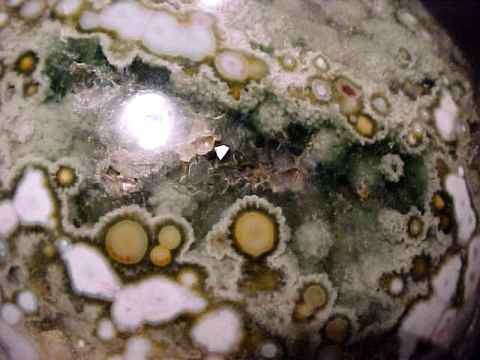


See our Virtual Gallery of Jasper jewelry &
MINERALMINERS.COM® - Your Personal 'Link' Direct to the Jasper Mines!TM
JASPER Information
Jasper is a variety of QUARTZ.
There are dozens of named jasper varieties including ocean jasper, polychrome jasper and leopard skin jasper.
See also our other Varieties of Quartz
Jasper Information Topics
Jasper Products For Sale in our Online Store:
Jasper Mineral Specimens and other Genuine Jasper Products in our Store
Return to the Index of
JASPER PHYSICAL PROPERTIES
- Jasper Chemical composition: SiO2
- Class: tectosilicate
- Crystal system: Hexagonal-R; 32 (trigonal-trapezohedral)
- Crystal habit: massive microgranular quartz
- Jasper Specific gravity: 2.58-2.91
- Index of refraction: 1.54-1.55
- Hardness: 6.5 to 7
- Color: red, brown or yellow, colored by finely disseminated hematite or goethite
- Luster: dull vitreous to greasy
- Jasper Transparency: translucent to opaque
- Cleavage: Cryptocrystalline quartz shows no cleavage, although parting may occur along laminations
- Fracture: conchoidal
- Streak: white
QUARTZ (Jasper) BACKGROUND INFORMATION
Jasper is a cryptocrystalline variety of the mineral Quartz (SiO2). Quartz is the most abundant single mineral on earth. It makes up about 12% of the earth's crust, occurring in a wide variety of igneous, metamorphic and sedimentary rocks.
Quartz varieties are commonly separated into two groups based on the size of the individual grains or crystals; macrocrystalline quartz in which individual crystals are distinguishable with the naked eye, and cryptocrystalline quartz in which the individual crystals are too small to be easily distinguishable under the light microscope.
Some of the macrocrystalline quartz varieties are: Amethyst, Ametrine, Cat's-eye Quartz, Citrine, Phantom Quartz , Rock Crystal, Rose Quartz, Rutilated Quartz and Smoky Quartz.
Blue Aventurine Quartz and Green Aventurine Quartz are actually quartzites (a rock, not a mineral) composed essentially of interlocking macrocrystalline quartz grains with disseminated grains of other color imparting minerals.
The cryptocrystalline varieties of quartz may be separated into two types;
fibrous and microgranular. ChalcedonyChalcedony is the general term
applied to the fibrous cryptocrystalline varieties.
Agate is an example of a fibrous cryptocystalline
banded chalcedony variety of quartz. Carnelian, Chrysoprase and bloodstone
are other chalcedony varieties.
Chert is the general term applied to the granular cryptocrystalline varieties of quartz, of which flint and Jasper are examples.
Return to the Index of
JASPER OCCURRENCE AND DIAGNOSTIC FEATURES
Jasper is a variety of chert, which is the general term applied to granular cryptocrystalline quartz varieties. Some jaspers are believed to form by the replacement of calcareous rock by silica-rich solutions, and also by direct marine precipitation of silica gel or organic silica.
Jasper is commonly associated with interbedded hematite ore deposits of Precambrian age.
Jasper occurs as a petrifying agent in fossil wood and bone. Jasper's typical reddish brown color is due to hematite or goethite impurities.
Jasper is characterized by its occurance, hardness, fracture, specific
gravity, refractive index and luster.
Return to the Index of Jasper Information Topics
JASPER HISTORICAL INFORMATION AND USES
Jasper has been used as gemstones and other ornamental objects for thousands of years.
In medieval times jasper was said to give the
wearer, with God's help, the power to heal insanity and to heal those
possessed by devils. In the fourth century, the wearing of green jasper was
said to bring rain and to cure snake bites.
Jasper amulets were engraved with passages from the Book of the Dead
by the ancient Egyptians to procure safe passage for the deceased in the
realm of the dead.
Some of the earliest primitive stone tools (axes) fashioned by man's ancestors 2.5 million years ago in the Omo valley in Ethiopia, were made of quartz varieties such as jasper or chert. These materials were used because of their hardness and their isotropic brittleness which made it possible to shape the tools with relative ease.
The astrological sign of jasper is leo.
Jasper is an alternate birthstone for the month of January.
Return to the Index of
JASPER METAPHYSICAL PROPERTIES
Jasper is said to provide protection, and to have a calming effect, giving stability and security. Jasper is also said to balance one's physical, emotional and intelectual states.
Jasper is said to help treat disorders of the kidneys and stomach, and to help remove toxins from the body. It is said to strengthen the liver and bladder, and to provide relief from intestinal ailments.For more in-depth metaphysical information, see our Metaphysical Books section.
Return to the Index of
Jasper Products in our Online Store
See all of our natural varieties of quartz:
Varieties of QUARTZ
Go up to the top of this
© Copyright 1998-2024 Gem & Mineral Miners, Inc.® All Rights Reserved.







